
The COVID-19 pandemic brought with it an unprecedented transition in the way that most Americans live. Social distancing, stay-at-home orders, school closures, and restrictions on business operations led to an increasing dependence on Internet access to accomplish everyday tasks like working, learning, and accessing healthcare. This reliance on an Internet connection brought an immense amount of attention to individuals and households without one—including calls to increase both the availability and affordability of broadband Internet access (Brake, 2020; Garcia and Smith, 2020; Stewart, 2020). This topic is a particularly important one for rural communities, where rates of broadband availability and adoption have long lagged behind those in urban areas. This paper paints a general picture of broadband progress in rural America prior to the COVID-19 pandemic, summarizes the broadband-related legislation passed as part of the response, and highlights rural experiences with schooling and healthcare during the transition to a more online-dominant environment. It emphasizes (1) the “homework gap” that was exacerbated during school shutdowns, and the approaches rural districts used to address it; and (2) the increase in telehealth seen during the pandemic, including variations in use by rural and urban residents. The results show that policy efforts geared toward improving broadband availability and use had only a small impact in the near term and that rural areas continue to be at a disadvantage in a world where more interactions are taking place online.
This is not a new topic. Broadband connectivity has the potential to influence nearly all aspects of rural life, including providing larger markets for small businesses, offering alternative ways of income generation for areas with few traditional businesses, allowing rural students to experience a wider array of educational opportunities, improving the scope of available health care services, raising farm profits via the use of precision agricultural techniques, and allowing access to a broader array of social interaction than is typically available in a small town. Rural development practitioners have for years emphasized the importance of broadband in many of these arenas (Parker, 2000; LaRose et al; 2007; Stenberg et al., 2009; Dickes, Lamie, and Whitacre, 2010; Whitacre et al., 2014a). However, the data continue to paint a strikingly familiar picture: rural areas lag behind their urban counterparts in the availability and adoption of broadband, gaps commonly referred to as the rural-urban version of the “digital divide.” The issue is widespread: Even before the pandemic, 58% of rural Americans believed that access to high-speed Internet was a problem in their area (Anderson, 2018).
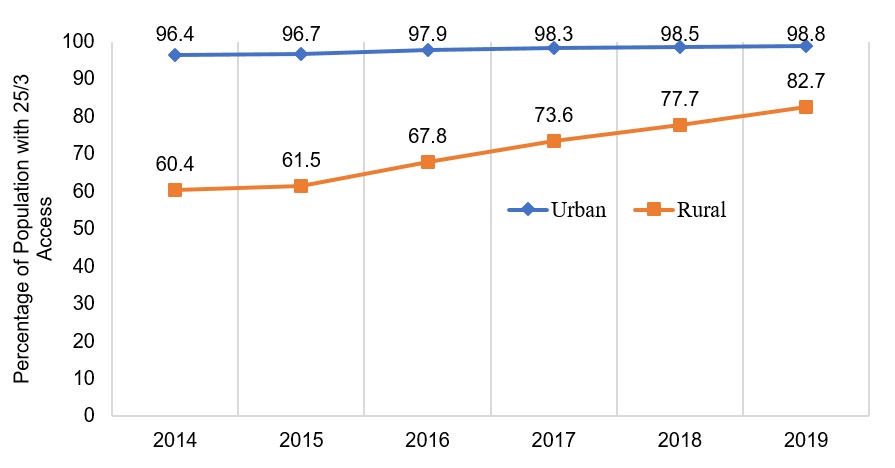
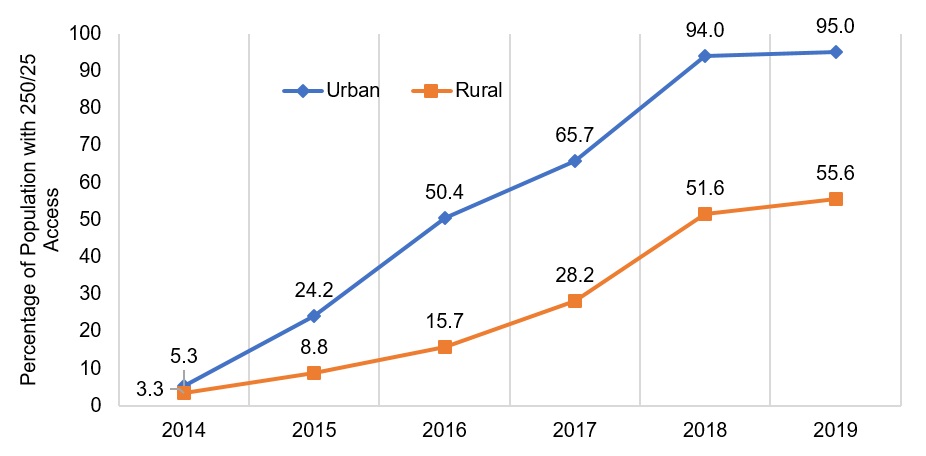
Note: The FCC defines "rural" at the census block level,
consisting of places with fewer than 2,500 people.
Source: FCC (2021).
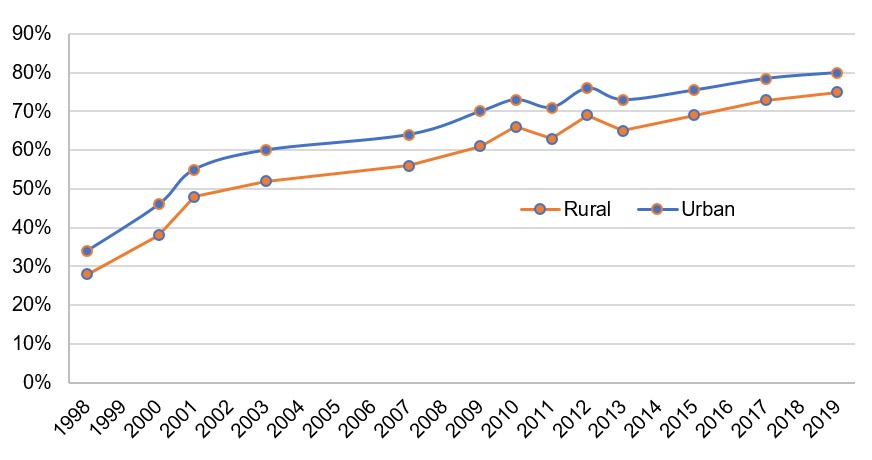
Note: The NTIA’s definition of “rural” follows the Office of
Management and Budget and uses county classifications where
counties that are not part of a metropolitan statistical area are
considered rural.
Source: NTIA (2020).
Economic theory predicts that rural areas will be the last to be served by Internet Service Providers (ISPs). With low population density, rough terrain, and lower levels of characteristics that often predict adoption (education, income, youth), rural locations offer a smaller return on investment than their urban counterparts. Installation costs vary by technology and can be expensive, with a mile of fiber optic cable averaging $27,000 (U.S. Department of Transportation, 2017). In some cases, the predicted profits may not cover the costs of installation, which is why these locations remain without a private provider of Internet access. Figure 1a demonstrates the progress that has been made since 2014 in connecting rural parts of the United States but also shows that significant gaps remain. The latest data, from 2019, show that 17.3% of rural residents lack access to the official Federal Communications Commission (FCC) definition of broadband (25 megabits per second (Mbps) download, 3 Mbps upload), compared with only 1.2% of urban residents. Figure 1b shows that the discrepancy is even more pronounced for faster speeds (250 Mbps download, 20 Mbps upload), where nearly half of all rural residents do not have such a connection available to them. Lai and Widmar (2021) use county-level speed test data to document an unsurprising negative correlation between download speeds and the degree of rurality during the initial phase of the pandemic.
Rural residents also lag in terms of broadband adoption (i.e., paying for monthly service). The National Telecommunications and Information Administration (NTIA) documents a persistent 5–10 percentage point gap between rural and urban residents for Internet use (any speed) over the period 1998–2019 (Figure 2). The FCC (2021) confirms that this holds specifically for 25/3 broadband, with household adoption rates of 73.3% for urban areas and 64.3% for rural ones as of 2019. Research has shown that roughly 40% of this broadband adoption gap is due to lower infrastructure availability in rural areas (Whitacre, Strover, and Gallardo, 2015). Socioeconomic characteristics such as age, income, and education are the main drivers behind the remaining 60%, leading to calls for demand-oriented policies that cater to lower-adopting demographics (Reddick et al., 2020).
A growing field of research has examined what broadband can mean for rural communities. Gallardo, Whitacre, and Grant (2017) summarize the literature, focusing on broadband’s impacts on economic development, civic engagement, education, telework, telehealth, and agriculture. While there is a general consensus that broadband is associated with positive outcomes in rural areas, a point of contention is whether availability or adoption matters more. Kim and Orazem (2017) show that the rollout of broadband availability during 2000–2002 was important for rural firms’ location decisions in Iowa and North Carolina, and Mack (2014) finds a link between broadband speeds and rural establishments in Ohio. There is also evidence that broadband availability is positively associated with rural in-migration (Mahasuweerachai, Whitacre, and Shideler, 2010), housing values (Deller and Whitacre, 2019), and farm sales and profits in rural counties (Kandilov et al., 2017). Finally, one recent study demonstrated that increasing broadband penetration was associated with increases in corn yields and lower farm operating expenses (LoPiccalo, 2020). Others have argued, however, that rural broadband adoption is more relevant—both for economic outcomes such as income and job growth (Whitacre, Gallardo, and Strover, 2014a,b) and for civic engagement (Whitacre and Manlove, 2016). The latter body of work makes the case for more demand-oriented policies such as subsidized broadband subscriptions or digital inclusion training; this is in direct contrast with the majority of previous federal policies, which focused exclusively on broadband infrastructure supply (Kruger, 2019).
Against this background—particularly the lower broadband availability and adoption rates in rural America—this paper explores the policy response to COVID-19 and assesses impacts to schoolwork and healthcare access.
The federal response to the COVID-19 pandemic included two distinct stimulus packages. The first was the $2.2 trillion Coronavirus Aid, Relief, and Economic Security (CARES) Act, which was signed into law on March 27, 2020. Several aspects of the CARES Act focused on broadband access and use, including (1) $13.5 billion in formula grants to states, which in turn distributed 90% of the funds to local K–12 educational agencies to support online learning; (2) $200 million to the FCC’s COVID-19 Telehealth Program; (3) $100 million for the U.S. Department of Agriculture’s ReConnect grant program for rural infrastructure; and (4) $50 million to the Institute of Museum and Library Services for digital inclusion projects (Taglang, 2020). During the first several months of the pandemic, more than 800 companies signed the “Keep Americans Connected” pledge indicating they would not terminate Internet service due to an inability to pay and would waive late fees (FCC, 2020). However, this pledge only ran through June 2020, and the ReConnect funding came with the caveat that all work be completed by the end of 2020—a difficult task when similar projects typically require months of planning (Bode, 2020).
The second stimulus package, a $900 billion measure passed in conjunction with the Consolidated Appropriations Act in December 2020, took a notably different approach to broadband (Kelly, 2020; Brodkin, 2020). It included $3.2 billion for $50-per-month subsidies to provide broadband access for low-income households or those laid off during the pandemic. This is a sizeable increase to the roughly $1 billion paid out annually under the FCC’s Lifeline program, which offers only a $10/month broadband subsidy for low-income households. This funding also allows participating Internet service providers to be reimbursed up to $100 for one laptop, desktop, or tablet per household. The bill also provides $1 billion for Tribal broadband programs, $300 million in rural broadband infrastructure grants, $250 million for telehealth programs, and $98 million to improve broadband mapping.
Even before the pandemic, the “homework gap”—the distinction between those K–12 students with high-speed home Internet service and a computer and those without—was sizable. Recent reports estimated that 15–17 million (30%) of school-age children lived in households without either a connection or a device adequate for distance learning (Chandra et al., 2020; Horrigan, 2020a). This percentage was roughly the same in rural and urban areas (Opalka et al., 2020). As schools transitioned to an online environment, the problem became more glaring. The biggest portion ($13.5 billion) of the broadband-related funding in the CARES Act went to support online learning for school districts in light of this situation. This money was largely used to provide wireless hotspots and laptops/tablets to households lacking such devices. However, a study completed in June 2020 found that during the early months of the pandemic, only 28% of rural schools were able to provide hotspot access for their students, compared to 48% for urban schools (Gross and Opalka, 2020). The gaps were even larger for the provision of laptops or tablet devices (48% rural, 85% urban). This report also noted that rural districts were much less likely to take attendance or monitor engagement during this time. In August, 65% of rural school districts were planning on returning to fully in-person classes for the fall, much higher than the 9% rate in urban districts (Gross, Opalka, and Gundapaneni, 2020). This was prior to the fall wave of the pandemic that hit the more rural parts of the country heavily and suggests that many districts may have been unprepared for longer-term distance learning.
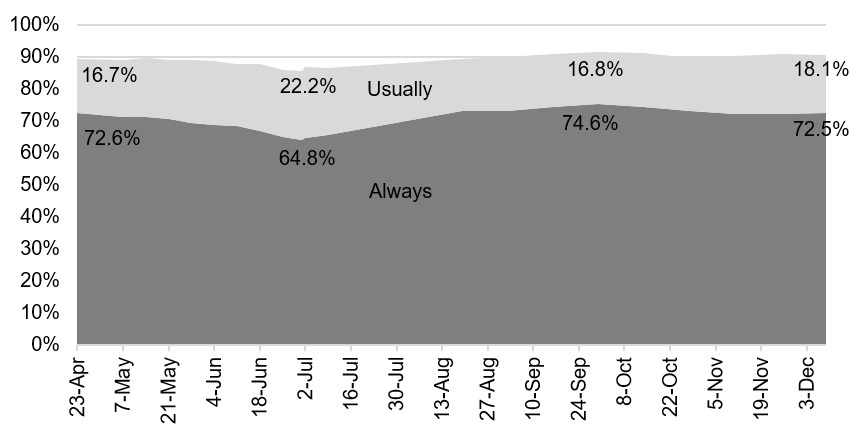
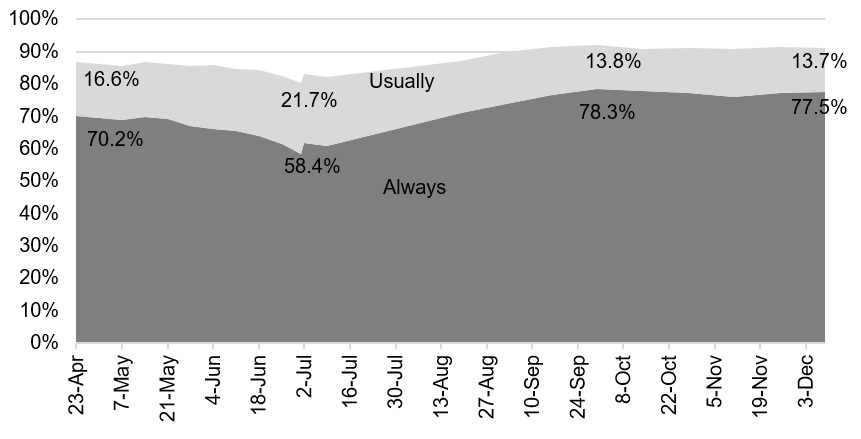
Source: U.S. Census Household Pulse Surveys Weeks 1–21
(2020), Education Table 3: “Computer and Internet Availability
in Households with Children.”
Figure 4. Percentage of Households with
K–12 Students Provided with Computer/
Internet Access from Schools, April–
December 2020
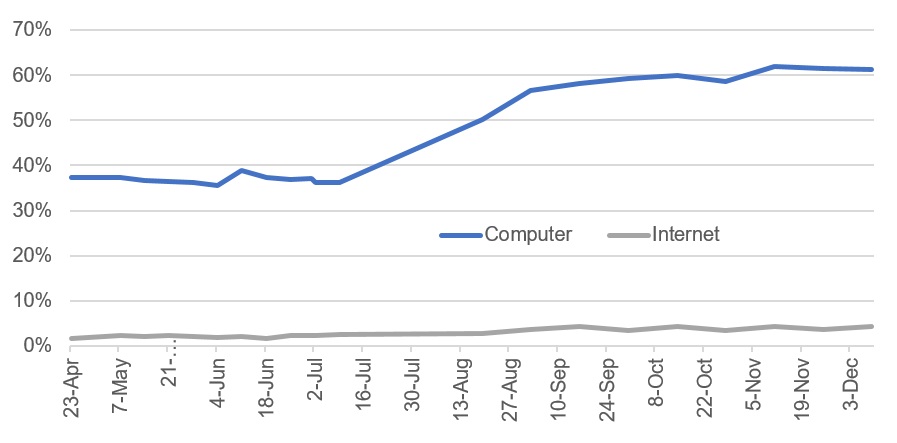
Source: U.S. Census Household Pulse Surveys Weeks 1–21
(2020), Education Table 3: “Computer and Internet Availability
in Households with Children.”
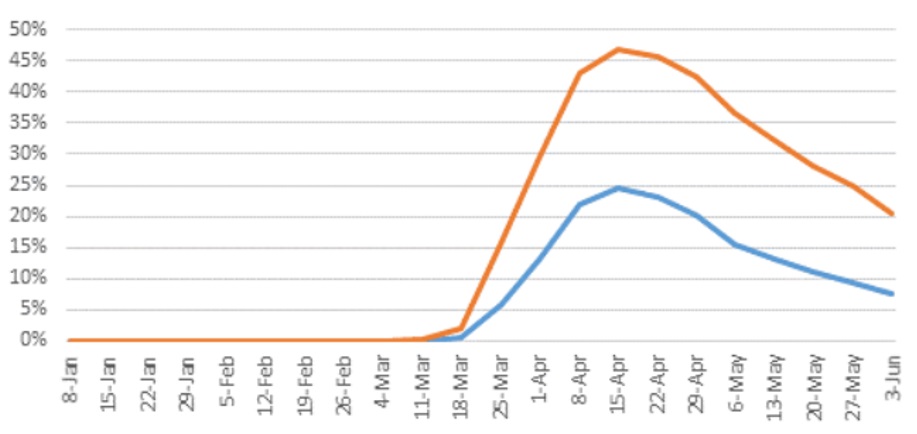
Source: Bosworth et al. (2020).
Evidence also suggests that the federal funding to support online learning was not particularly effective at bridging the Internet portion of the homework gap during the latter part of 2020. Horrigan (2020b) notes that Census Pulse surveys can be used to identify how successful these efforts have been. This data demonstrates that between May and December 2020, the percentage of student households indicating that the Internet was always available for educational purposes essentially stayed flat at 73% (Figure 3a). It does appear that school districts were more successful at getting computers to their students, as the percentage of student households with a device always available to them increased from 70% to 78% during that time (Figure 3b). The surveys (which unfortunately do not break out rural/urban status) also asked about who provided the computer/Internet service. By December, 61% of households with K–12 students had a computer that was provided by the child’s school, but only 4% indicated that their Internet service was paid for by the school (Figure 4).
Some rural districts went beyond trying to provide hotspots to their students to address the connectivity issue. Such efforts included creating maps of places in the local community with free wi-fi; helping families to connect with low-cost Internet options; upgrading the school’s wi-fi to reach the parking lot with sufficient bandwidth for multiple students; constructing workspaces in school parking lots; and even parking wi-fi enabled buses in rural communities (Nicola, Gable, and Ash 2020; Thompson, 2020). Some districts reported loading prerecorded lectures onto USB drives or hand-delivering paper packets and then communicating via phone and text.
It is too early to know whether the more recent stimulus broadband funding—with its $50/month subsidies—will have a meaningful impact on the homework gap in rural areas. Digital inclusion advocates have argued that affordability, and not infrastructure availability, is the biggest barrier to increasing adoption rates. This holds for rural areas as well: Over 60% of rural households earning less than $20,000 had no broadband subscriptions of any type in 2017, compared to only 14% of those earning $75,000 or more (NDIA, 2019).
Another large shift in everyday life during the COVID-19 pandemic was the transition to online access for healthcare. Many doctors and hospitals cut back dramatically on in-person visits—and the use of telehealth (typically defined as the delivery of health care via remote technologies) quickly accelerated. Medicare and Medicaid rapidly loosened their restrictions on the types of telehealth visits allowed and where the visits could take place (CMS, 2020). However, researchers were quick to voice concern that rural constituents might be left behind during this change (Hirko et al. 2020; Ramsetty and Adams 2020). Broadband access was a particular worry: Prior evidence noted that the gap in connection speeds between rural and urban physician offices has been increasing over time (Whitacre, Wheeler, and Landgraf, 2017) and that broadband availability was an important determinant of telehealth use (Wilcock et al., 2019; Drake et al. 2019). The limited data available from health encounters after the pandemic suggests that this concern is valid: Telehealth visits rose from less than 1% of all Medicare primary care visits in February 2020 to nearly 50% in urban areas by mid-April but only comprised 25% of visits in rural locations (Bosworth et al., 2020) (Figure 5). Another study, comparing health encounters between March 2019 and March 2020, showed that living in a rural area decreased the likelihood of telehealth use at the onset of the pandemic (Jaffe et al., 2020). Thus, rural areas seemed to be participating less in telehealth during the early phases of the pandemic.
The federal government expanded reimbursements for telehealth services and provided a significant amount of funding (in both stimulus packages) to support telehealth efforts. This includes financial support to clinics in underserved communities, such as those in rural locations. It also funded connected devices—such as tablets, smart phones, or monitoring devices—that may not require traditional wireline broadband access (and instead use cellular service). However, adopting this new method of healthcare is dependent on the health and digital literacy of the populations being served. Rural America typically lags behind its urban counterparts on both of these topics, so simply paying for connected devices is not likely to solve the underlying issues. Many rural providers have recognized this—along with local broadband availability issues—and offered traditional phone calls in lieu of video appointments (Hirko et al., 2020).
The COVID-19 pandemic brought with it a clear realization of the importance of broadband and put those without such a connection at an even bigger disadvantage than they faced in a non-socially distanced world. Two integral parts of our society—going to school and obtaining health care—largely transitioned to online environments during this time. Rural residents, with lower levels of broadband availability and adoption, faced additional difficulties during this change. While the federally funded stimulus packages have included significant broadband components, they do not appear to have meaningfully impacted these elements during the early part of the pandemic: Very few homes with school-age children reported having their Internet service paid for by an outside source, and rural residents remained less likely to use telehealth. The lessons learned include that addressing the digital divide is not a short-term process: A quick infusion of cash cannot roll out wireline infrastructure in just a few months, and it appears to be much more difficult to deliver home Internet service to students than it is to provide them with computers (Horrigan, 2020b). Nonetheless, the COVID-19 broadband funds are unique in that they recognize both the availability and adoption components of the divide. The $50 monthly broadband subsidy is an important change from previous policies, telehealth funds can pay for connected devices (not available under earlier policies) to receive health care at home, and the infrastructure funding builds on prior federal efforts.
Broadband will continue to be an important topic for rural communities in a post-pandemic society. While this article focused on schooling and healthcare, other components of rural life are also clearly linked to broadband availability and use. In particular, the ability to work from home is vital for increasing opportunities for rural workers and allowing for in-migration of urban workers who are geographically flexible. There are also implications for civic engagement, housing values, and agricultural productivity. COVID-19 pushed the broadband policy envelope forward, but largely failed to deliver short-term results for rural residents. Whether impacts are seen over the longer term remains to be seen.
Anderson, M. 2018, September 10. “About a Quarter of Rural Americans Say Access to High-Speed Internet Is a Major Problem.” Pew Research Center FactTank. Available online: https://www.pewresearch.org/fact-tank/2018/09/10/about-a-quarter-of-rural-americans-say-access-to-high-speed-Internet-is-a-major-problem/.
Bode, K. 2020, November 3. “CARES Act Broadband Funding Came with Unrealistic Deadlines, Ruining Good Intentions.” Tech Dirt. Available online: https://www.techdirt.com/articles/20201103/07292645636/cares-act-broadband-funding-came-with-unrealistic-deadlines-ruining-good-intentions.shtml.
Bosworth, A., J. Ruhter, L.W. Samson, S. Sheingold, C. Taplin, W. Tarazi, and R. Zuckerman. 2020. “Medicare Beneficiary Use of Telehealth Visits: Early Data from the Start of COVID-19 Pandemic.” Washington, DC: U.S. Department of Health and Human Services, Office of the Assistant Secretary for Planning and Evaluation.
Brake, D. 2020, July 13. “Lessons from the Pandemic: Broadband Policy after COVID-19.” Information Technology & Innovation Foundation. Available online: https://itif.org/publications/2020/07/13/lessons-pandemic-broadband-policy-after-covid-19.
Brodkin, J. 2020. “$50-per-month Emergency Broadband Subsidies Approved in Pandemic Stimulus.” Ars Technica. Available online: https://arstechnica.com/tech-policy/2020/12/50-per-month-emergency-broadband-subsidies-approved-in-pandemic-stimulus/.
Centers for Medicare and Medicaid Services (CMS). 2020. “Covered Telehealth Services during the COVID-19 Pandemic, Effective March 1, 2020.” Washington, DC: Centers for Medicare & Medicaid Services. Available online: https://www.cms.gov/Medicare/Medicare-General-Information/Telehealth/Telehealth-Codes.
Chandra, S., A. Chang, L. Day, A. Fazlullah, J. Liu, L. McBride, T. Mudalige, and D. Weiss. 2020. Closing the K-12 Digital Divide in the Age of Distance Learning. Boston, MA: Common Sense Media. Available online: https://www.commonsensemedia.org/sites/default/files/uploads/pdfs/common_sense_media_report_final_6_29_12-42pm_web_updated.pdf.
Deller, S., and B. Whitacre. 2019. “Broadband’s Relationship to Rural Housing Values.” Papers in Regional Science 98: 2135–2156.
Dickes, L., R. Lamie, and B. Whitacre. 2010. “The Struggle for Broadband in Rural America.” Choices 25(4).
Drake, C., Y. Zhang, K.H. Chaiyachati, and D. Polsky. 2019. “The Limitations of Poor Broadband Internet Access for Telemedicine Use in Rural America: An Observational Study.” Annals of Internal Medicine 171(5): 382–384.
Federal Communications Commission (FCC). 2020. “Keep Americans Connected Pledge.” Available online: https://www.fcc.gov/keep-americans-connected.
Federal Communications Co. 2021. Fourteenth Broadband Deployment Report. Washington, DC: Federal Communications Commission, FCC 21-18. Available online: https://docs.fcc.gov/public/attachments/FCC-21-18A1.pdf.
Gallardo, R., B. Whitacre, and A. Grant. 2017. Broadband’s Impact: A Brief Literature Review. West Lafayette, IN: Purdue University Center for Regional Development, Publication 001.
Garcia, C., and S. Smith. 2020, April 20. “Coronavirus and the Digital Divide.” National Public Radio. Available online: https://www.npr.org/2020/04/20/839270995/coronavirus-and-the-digital-divide.
Gross, B., and A. Opalka A. 2020. Too Many Schools Leave Learning to Chance during the Pandemic. Center on Reinventing Public Education. Available online: https://www.crpe.org/sites/default/files/final_national_sample_brief_2020.pdf
Gross, B., A. Opalka, A., and Gundapaneni, P. 2020. Getting Back to School: An Update on Plans from across the Country. Center on Reinventing Public Educations. Available online: https://www.crpe.org/sites/default/files/getting_back_to_school_brief.pdf
Hirko, K., J. Kerver, S. Ford, C. Szafranski, J. Beckett, C. Kitchen, and A. Wendling. 2020. “Telehealth in Response to the COVID-19 Pandemic: Implications for Rural Health Disparities.” Journal of the American Medical Informatics Association 27(11): 1816–1818.
Horrigan, J. 2020a. “Students of Color Caught in the Homework Gap.” Future Ready Schools. Available online: https://futureready.org/homework-gap/.
Horrigan, J. 2020b. “Census Pulse Data Shows Some Growth in Computer Access for Students, But Not Much for Internet Availability at Home.” Benton Institute for Broadband & Society. Available online: https://www.benton.org/blog/digital-tools-learning
Jaffe, D., L. Lee, S. Huynh, and T. Haskell. 2020. “Health Inequalities in the Use of Telehealth in the United States in the Lens of COVID-19.” Population Health Management 23(5): 368–377.
Kandilov, A., I. Kandilov. X. Liu, X., and Renkow, M. 2017. “The Impact of Broadband on U.S. Agriculture: An Evaluation of the USDA Broadband Loan Program.” Applied Economic Perspectives and Policy 39(4): 635–661.
Kelly, M. 2020. “US Relief Package Provides $7 Billion for Broadband.” The Verge. Available online: https://www.theverge.com/2020/12/21/22193133/us-coronavirus-covid-relief-stimulus-package-broadband-huawei-zte
Kim, Y., and P. Orazem. 2017. “Broadband Internet and New Firm Location Decisions in Rural Areas.” American Journal of Agricultural Economics 99(1): 285–302.
Kruger, L. 2019. “Broadband Internet Access and the Digital Divide: Federal Assistance Programs.” Washington, DC: Congressional Research Service Report RL30719.
Lai, J., and N. Widmar. 2021. “Revisiting the Digital Divide in the COVID-19 Era.” Applied Economics Perspectives and Policy43(1): 458-464.
LaRose, R., J.L. Gregg, S. Strover, J. Straubhaar, and S. Carpenter. 2007. “Closing the Rural Broadband Gap: Promoting Adoption of the Internet in Rural America.” Telecommunications Policy 31(6–7): 359–373.
LoPiccalo, K. 2020. “Impact of Broadband Penetration on US Farm Productivity.” SSRN 3749647.
Mack, E. 2014. “Businesses and the Need for Speed: The Impact of Broadband Speed on Business Presence.” Telematics and Informatics 31(4): 617–627.
Mahasuweerachai, P., B. Whitacre, and D. Shideler. 2010. “Does Broadband Access Impact Migration in America? Examining Differences between Rural and Urban Areas.” Review of Regional Studies 40(1): 5–26.
National Digital Inclusion Alliance (NDIA). 2019.“NDIA to FCC: Broadband Affordability Should Be Addressed in Annual Assessment. Available online: https://www.digitalinclusion.org/blog/2019/11/25/ndia-to-fcc-broadband-affordability-should-be-addressed-in-annual-assessment/.
National Telecommunications and Information Association (NTIA). 2020. “Digital Nation Data Explorer.” Available online: https://www.ntia.gov/data/digital-nation-data-explorer.
Nicola, T., A. Gable, and J. Ash. 2020. “The Response of Rural Districts to the COVID-19 Pandemic.” National Center for Rural Education Research Networks. Available online: https://cepr.harvard.edu/files/cepr/files/ncrern_report.pdf
Opalka A., A. Gable, T. Nicola, and J. Ash. 2020. “Rural School Districts Can Be Creative in Solving the Internet Connectivity Gap—But They Need Support.” [Blog post]. Brookings Institute. Available online: https://www.brookings.edu/blog/brown-center-chalkboard/2020/08/10/rural-school-districts-can-be-creative-in-solving-the-Internet-connectivity-gap-but-they-need-support/.
Parker, E. 2000. “Closing the Digital Divide in Rural America.” Telecommunications Policy 24(2): 281–290.
Ramsetty, A., and C. Adams. 2020. “Impact of the Digital Divide in the Age of COVID-19.” Journal of the American Medical Informatics Association 27(7): 1147–1148.
Reddick, C., R. Enriquez, R. Harris, and B. Sharma. 2020. “Determinants of Broadband Access and Affordability: An Analysis of a Community Survey on the Digital Divide.” Cities 106: 102904.
Stenberg, P., M. Morehart, S. Vogel, and J. Cromartie. 2009. Broadband Internet’s Value for Rural America. Washington, DC: U.S. Department of Agriculture, Economic Research Service, Economic Research Report ERR-78, August.
Stewart, E. 2020, September 10. “Give Everybody the Internet.” Vox. Available online: https://www.vox.com/recode/2020/9/10/21426810/Internet-access-covid-19-chattanooga-municipal-broadband-fcc.
Taglang, K. 2020. “How Does the CARES Act Connect Us?” Benton Institute for Broadband and Society. Available online: https://www.benton.org/blog/how-does-cares-act-connect-us.
Thompson, S. 2020. “Wi-Fi Equipped School Buses to Prepare Students for Homeschooling.” School Bus Fleet. Available online: https://www.schoolbusfleet.com/10112966/wi-fi-equipped-school-buses-to-prepare-students-for-homeschooling.
U.S. Census Bureau. 2020. “Household Pulse Survey Data Tables.” Available online: https://www.census.gov/programs-surveys/household-pulse-survey/data.html.
U.S. Department of Transportation. 2017. “Sample Unit Cost Entries for Fiber Optic Cable Installation.” Washington, DCL U.S Department of Transportation, Office of the Assistant Secretary for Research and Technology, Intelligent Transportation Systems Joint Program Office. Available online: https://www.its.dot.gov/research_archive.htm.
Whitacre, B., R. Gallardo and S. Strover. 2014a. “Broadband’s Contribution to Economic Growth in Rural Areas: Moving toward a Causal Relationship.” Telecommunications Policy 38(11): 1011–1023.
Whitacre, B., R. Gallardo and S. Strover. 2014b. “Does Rural Broadband Impact Jobs and Income? Evidence from Spatial and First-differenced Regressions.” Annals of Regional Science 53(3): 649–670.
Whitacre, B., and J. Manlove. 2016. “Broadband and Civic Engagement in Rural Areas: What Matters?” Community Development 47(5): 700–717.
Whitacre, B., S. Strover, and R. Gallardo. 2015. “How Much Does Broadband Infrastructure Matter? Decomposing the Rural—Urban Adoption Gap with the Help of the National Broadband Map.” Government Information Quarterly 32(3): 261–269.
Whitacre, B., D. Wheeler, and C. Landgraf. 2017. “What Can the National Broadband Map Tell Us about the Healthcare Connectivity Gap?” Journal of Rural Health 33(3): 284–289.
Wilcock, A.D., S. Rose, A.B. Busch, H.A. Huskamp, L. Uscher-Pines, B. Landon, and A. Mehrotra. 2019. “Association between Broadband Internet Availability and Telemedicine Use.” JAMA Internal Medicine 179(11): 1580–1582.